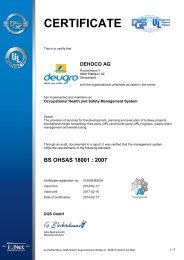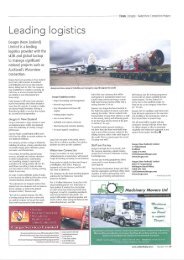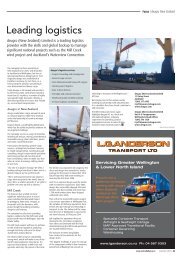CASES
Create successful ePaper yourself
Turn your PDF publications into a flip-book with our unique Google optimized e-Paper software.
Five years in the planning. One new airport - and 88 cargo<br />
flights in 103 days delivering 6,000 tons. Thanks to an<br />
outstanding team of partners, in 2014 the world’s second<br />
largest natural gas deposits in the Southern Highlands and<br />
Western Provinces of Papua New Guinea will begin the first<br />
gas supplies to consumers in Asia.<br />
<strong>CASES</strong>
TUDY<br />
This is the story of how logistics,<br />
infrastructure and gas production<br />
and processing specialists came<br />
together to turn an ambitious project<br />
plan into a reality.
cargosuper market<br />
CASE STUDY<br />
WITH TEAMWORK,<br />
ANYTHING IS<br />
POSSIBLE<br />
Finding natural oil and gas<br />
energy reserves is challenging<br />
enough but extracting them<br />
can be even more complex and<br />
capital intensive and leaves no<br />
margin for error.<br />
Increasingly, the world’s leading energy<br />
corporations have to target more remote<br />
regions of the planet to develop new<br />
processing and pumping facilities. The<br />
risks are high but so too are the rewards<br />
and economic benefits for both industry<br />
and national and local economies.<br />
In Papua New Guinea, the discovery of<br />
natural gas deposits in its Hela, Southern<br />
Highlands and Western Provinces<br />
offered the potential to increase the<br />
country’s GDP. ExxonMobil PNG Limited,<br />
the operator of the PNG LNG Project,<br />
estimates that over the life of the gas<br />
production and processing project, over<br />
nine trillion cubic feet of gas will be<br />
produced and sold. The company began<br />
construction of the Project in 2010 and<br />
the first LNG will be exported in the<br />
second half of 2014.<br />
But first there was a major<br />
logistics challenge.<br />
Building a gas conditioning plant in<br />
the Highlands of Papua New Guinea<br />
was not going to be easy. The region<br />
is predominantly rugged mountainous<br />
terrain and conditions are made more<br />
challenging by the 9,000mm of rainfall in<br />
the area throughout the year.<br />
Logistically the biggest challenge was to<br />
deliver equipment and materials from<br />
the ports of Lae and Port Moresby to<br />
the Hides Gas Conditioning Plant, which<br />
is located in the Southern Highlands of<br />
Papua New Guinea at an elevation of over<br />
1500m. A large percentage of the 800kms<br />
of road from Lae are dirt tracks with<br />
gradients of over 20% and there are 99<br />
bridge crossings on the route as well. The<br />
maximum gross vehicle weight on a lot<br />
of the bridges is limited to 60,000kg, so<br />
with prime mover and trailer weights the<br />
maximum cargo weight via road was low<br />
by industry standards at around 25,000<br />
kilos. Additionally, the road between<br />
Lae and Hides has been subject to road<br />
closures due to landslides, washouts and<br />
other uncontrollable factors.<br />
Over 7,000 loads have already travelled<br />
this route. However, the Hides plant<br />
also required a lot of large, delicate<br />
and sensitive equipment in order to<br />
commence operation and the poor quality<br />
roads and restrictions between Lae and<br />
the jobsite were deemed not suitable<br />
to transport these materials. Another<br />
transport solution was clearly required.<br />
ExxonMobil recognised that to overcome<br />
these challenges would require an<br />
innovative logistics solution – and a lot of<br />
‘thinking outside of the box’.
PNG LNG PROJECT<br />
cargosuper market<br />
‘For us, it was not just a commercial project but the chance to test ourselves again’<br />
ExxonMobil contracted Volga-Dnepr<br />
Airlines, the world’s largest transporter<br />
of outsize and heavyweight air cargo,<br />
which over more than 20 years had<br />
demonstrated its unique ability to ‘make<br />
the impossible possible’.<br />
When teams of specialists from<br />
ExxonMobil and Volga-Dnepr first<br />
got together in 2008 to discuss the<br />
project, one question dominated the<br />
conversation: was it theoretically possible<br />
to fly thousands of tonnes of large, heavy,<br />
complex and sensitive equipment into<br />
the remote Highlands of Papua New<br />
Guinea to enable the building of a gas<br />
conditioning plant?<br />
The combined expertise and knowledge<br />
of the two organisations established that<br />
undertaking such a complex air logistics<br />
task was indeed possible – but first they<br />
had to build an airport.<br />
For Volga-Dnepr, working on projects<br />
some years in advance of performing<br />
an actual flight operation is part and<br />
parcel of its unique place in the world<br />
of aviation. The size and design of big<br />
pieces of high value industrial equipment,<br />
aircraft components and space satellites<br />
are often based on their ability to fit<br />
into the airline’s fleet of giant Antonov<br />
An-124 freighters because major global<br />
corporations recognise the vital role<br />
Volga-Dnepr plays in their supply chain.<br />
In the first phase of their cooperation, a<br />
joint team from ExxonMobil and Volga-<br />
Dnepr travelled to Papua New Guinea<br />
to evaluate four proposed locations<br />
for a new Highlands airport. This was<br />
subsequently reduced to two sites<br />
following inspections and, ultimately, one<br />
location in Komo based on Volga-Dnepr’s<br />
study of load lists and route options.<br />
Back in the UK, members of ExxonMobil’s<br />
PNG LNG Project team met with the<br />
airline to plan how many An-124 flights<br />
would be required, which routes would<br />
be used, the frequency of operations,<br />
the length of the project and flight<br />
programme, and the costs involved.<br />
In 2010, work began on the new<br />
Komo Airfield.<br />
To be able to handle An-124 freighter<br />
operations would require building Papua<br />
New Guinea’s longest paved runway at<br />
3,200m in length and 45m wide. Once<br />
complete the new airport would be able<br />
continued on page 12
cargosuper market<br />
CASE STUDY<br />
‘deugro and Volga-Dnepr Airlines<br />
were brought together early on in<br />
the project in putting together a<br />
unique trailer loading and<br />
off-loading concept to reduce<br />
the overall ground handling<br />
times for the aircraft’<br />
continued from page 11<br />
to welcome the world’s largest seriesproduced<br />
cargo aircraft with its 73 metre<br />
wingspan, maximum take-off weight of<br />
392 tons and payload of up to 120 tonnes.<br />
It would feed construction equipment<br />
and materials virtually to the door of the<br />
gas processing site through a series of<br />
90-minute flights from Port Moresby.<br />
The Soviet-built An-124 makes light<br />
work of logistics projects well beyond the<br />
capability of other commercial airliners.<br />
In terms of cargo handling, the aircraft is<br />
virtually self sufficient. Craneless loading<br />
and offloading technology saves hours<br />
and eliminates any additional costs arising<br />
from the need for third party handling<br />
equipment. In this case, reducing the time<br />
the aircraft needed to spend on the ground<br />
was essential to the one-flight-per-day<br />
schedule set for the project.<br />
Another key partner in the Hides project<br />
was deugro, which was awarded the<br />
contract for the international freight<br />
forwarding and logistics package as well<br />
as the Papua New Guinea in-country<br />
marshalling facility in Port Moresby and<br />
heavy-haul service package for delivery to<br />
the Hides Gas Conditioning Plant – in total,<br />
managing the delivery of some 72,500<br />
metric tonnes.<br />
Via the establishment of a purpose-built<br />
marshalling yard facility at Jacksons<br />
International Airport, deugro’s Port<br />
Moresby office managed the inbound<br />
customs clearance, storage and handling<br />
of the heavy and outsize pieces of<br />
equipment prior to their ultimate loading<br />
onto the Antonov 124 aircraft for onwards<br />
delivery to Komo.<br />
In Komo, it was again deugro that was<br />
responsible for receiving the heavy and<br />
outsize equipment from the An-124 aircraft<br />
and delivering the equipment over the final<br />
25 kilometers to the plant.<br />
Richard Jürgens, Project Manager for<br />
deugro Projects (Australia) says: “A project<br />
of this scale has never been attempted<br />
within PNG. The infrastructure one<br />
takes for granted in a developed Oil &<br />
Gas environment was not present. This<br />
meant a massive investment in additional<br />
resources, skills and subsequent training<br />
and infrastructure development was<br />
needed, to up-scale the roads, bridges,<br />
transportation equipment and network<br />
to cope with the logistics demands of the<br />
various contractors.<br />
Route surveys, transport studies and<br />
infrastructure analysis in respect to bridge<br />
strength and capacity, road surfaces,<br />
bends and inclines were conducted by<br />
deugro’s transport engineering team more<br />
than a year in advance to ensure that the<br />
ultimate transport equipment utilized<br />
remained the best fit to what essentially<br />
became forever changing conditions.<br />
”The remote and at times volatile location,<br />
the lack of locally available support<br />
equipment and technicians and adverse<br />
weather conditions steered the logistics<br />
approach, particularly from a heavy haul<br />
and project logistics perspective, to one of<br />
being completely self-reliant.<br />
“This lent to establishing a fully competent<br />
team of experienced operators familiar<br />
with the risks of operating heavy transport<br />
equipment in such harsh conditions,<br />
to consistently ensure the delivery of<br />
materials to the construction site day<br />
after day.“<br />
A key factor in the success of the logistics<br />
project was the cooperation of the partners<br />
from an early stage. Richard Jürgens<br />
adds: “deugro and Volga-Dnepr Airlines<br />
were brought together early on in the<br />
‘The remote and at times volatile location,the lack of locally available<br />
support equipment and technicians and adverse weather conditions steered the<br />
logistics approach’
PNG LNG PROJECT<br />
cargosuper market<br />
‘A project of this scale has never<br />
been attempted within PNG.<br />
The infrastructure one takes for<br />
granted in a developed Oil & Gas<br />
environment was not present’<br />
project in putting together a unique trailer<br />
loading and off-loading concept to reduce<br />
the overall ground handling times for the<br />
aircraft, ensuring a quick turn-around time<br />
of the An-124. Volga-Dnepr’s technical<br />
capability and loading concepts were a key<br />
factor in it winning the ‘airbridge’ contract<br />
and deugro was able to compliment this<br />
with our specialised hydraulic trailers<br />
specifically imported into PNG to execute<br />
the heavy haul scope of works for the<br />
project.<br />
“deugro’s Technical Engineering<br />
Department worked closely with Volga-<br />
Dnepr’s technical team to formulate a<br />
modular hydraulic trailer-design providing<br />
sufficient incline and deck strength to<br />
successfully create a direct link between<br />
the An-124 ramp and trailer, thereby<br />
eliminating the need for additional ramps<br />
and cranes which ultimately add to the<br />
operational cost, safety risk and turnaround<br />
time per flight.”<br />
Additional work was conducted by the<br />
airline to minimise the empty weight of the<br />
An-124-100 aircraft, tooling and packaging<br />
equipment to maximise the opportunities<br />
offered by the freighter’s cargo capacity<br />
and Volga-Dnepr also developed solutions<br />
to ensure the appropriate maintenance of<br />
aircraft at Port Moresby airport during<br />
the project.<br />
After five years of planning, Volga-Dnepr’s<br />
first An-124 flight touched down on the<br />
new runway at Komo Airfield on May<br />
3rd 2013. A sense of great pride and<br />
achievement was felt by everyone involved<br />
in the project – but this was just the start of<br />
an intensive flying programme.<br />
Over the next 103 days, 88 Volga-Dnepr<br />
An-124 cargo flights safely transported<br />
6,000 tons of equipment and materials that<br />
would help to turn an ambitious project<br />
plan into a reality. For Volga-Dnepr, it was<br />
mission accomplished.<br />
Dennis Gliznoutsa, Vice<br />
President, Development<br />
at Volga-Dnepr Airlines,<br />
said: “This project was<br />
complex and an interesting<br />
logistics challenge and<br />
we are proud to have<br />
worked in partnership<br />
with our colleagues at ExxonMobil and<br />
deugro. Papua New Guinea is a country<br />
that has challenging climatic conditions,<br />
including highlands with frequent fog. We<br />
are proud to have successfully and safely<br />
completed this project by overcoming all<br />
of these difficulties and by once again<br />
demonstrating our expertise in the safe<br />
delivery of unique and outsize cargo. For<br />
us it was not only a commercial project<br />
but the opportunity to test ourselves again.<br />
Participation in this project has also helped<br />
us to strengthen our cooperation with<br />
regular customers and to acquire potential<br />
partners.”<br />
The ‘airbridge’ supplied the main logistics<br />
solution for the Hides Gas Conditioning<br />
Plant in that it allowed the project to<br />
deliver most of the major equipment<br />
required to complete the project by<br />
avoiding the 800km road between Lae<br />
and the plant. The equipment transported<br />
on the An-124-100s included the Main<br />
Compressors, Gas Turbine Generators,<br />
Pressure Vessels, Heat Exchangers and all<br />
of the Equipment Rooms for the process<br />
facility.<br />
In 2014, ExxonMobil will deliver its first gas<br />
supplies to consumers in Asia – proving<br />
once again that by combining the best<br />
human spirit, endeavour and engineering,<br />
there is no logistics challenge that cannot<br />
be overcome.






